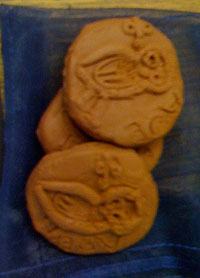
Greek coins project: Athenian coins, made by 6th graders at Laurelhurst School, Portland
How minters made Greek coins
Each Greek city made its own silver coins. The cities they made their coins to look different from each other. That way you could know right away which city the coins were from, and whether to trust that the coin had as much silver in it as that city said it did.
More about Greek coins
Coins from Thebes
History of money
The Greek economy
All our ancient Greece articles
Greek minters made coins by putting a blank coin on a metal stand that had an image carved into it. Then you set a metal punch (like a stick as big around as one coin) on top. This had a different image carved into it. Then you hit the metal punch with a hammer. That would drive it into the coin and transfer both images. One image would be on the front of the coin and the other on the back of the coin.
This was the same way that Persians, Etruscans, Carthaginians, and Egyptians made their coins. Some of these other places made coins before the Greeks, and probably the Greeks learned how from the Lydians.

Athenian coin with Athena’s owl on it.
A Greek coins project
You can make your own Greek coins out of clay. These Athenian coins have the owl of Athena on them, and they say “ATHE” in Greek letters. These were made by laying thin strips of clay on top of the coin, but you could also try carving a punch out of wood and using that to make the image.
Who was Athena?
The Greek alphabet
Classical Athens
More about Greek coins
Other activities:
Olympic games
Play reading
Vase-painting
Bibliography and further reading for Ancient Greek projects:
Hands-On Ancient People, Volume 2 : Art Activities about Minoans, Mycenaeans, Trojans, Ancient Greeks, Etruscans, and Romans (2004) For kids ages 9-12.
Ancient Greece!: 40 Hands-On Activities to Experience This Wondrous Age (Kaleidoscope Kids), by Avery Hart, Paul Mantell, and Michael P. Kline (1999). Gives ideas to get kids thinking, rather than step-by-step instructions.




